Application of EPMA and LA-ICP-MS to Study Mineralogy of Arsenopyrite from the Haoyaoerhudong Gold Deposit, Inner Mongolia, China
-
摘要: 毒砂的主微量元素组成可以用于判断元素的赋存状态,探讨元素在不同阶段的活化迁移行为。内蒙古浩尧尔忽洞金矿床是产自白云鄂博群黑色岩系中的一个超大型金矿,发育重要载金矿物毒砂和斜方砷铁矿。前人利用传统粉末溶样法对矿石进行同位素分析,探讨了成矿物质来源,但金的迁移富集机制尚未获得解决。为探讨该矿床金迁移富集过程,本文在矿相学的基础上,对不同类型的毒砂进行电子探针(EPMA)和电感耦合等离子体质谱(ICP-MS)测试。所测得的电子探针数据经ZAF程序校正,LA-ICP-MS数据采用“无内标-基体归一法”进行定量计算,可以有效地分析微区成分。结果显示:毒砂(Apy)内部发育斜方砷铁矿(Lo),可分为递进剪切变形阶段的Apy-Ⅰ1、Apy-Ⅰ2、Lo-Ⅰ和后剪切变形阶段的Apy-Ⅱ1、Apy-Ⅱ2、Lo-Ⅱ。各世代毒砂主元素组成稳定,含有少量Co、Ni和微量Sb、Te、Bi、Pb、Au、Ag。其中,Co在Apy-Ⅱ1和Apy-Ⅱ2中偏高,微量元素Au、Bi、Pb、Te在Apy-Ⅰ1中明显富集。斜方砷铁矿富As(64.06%~67.87%),含Co(0.33%~4.98%)、Ni(1.23%~6.37%),微量元素Au、Te、Bi、Pb、Ag在Lo-Ⅱ中更富集。研究表明,Lo-Ⅱ是最主要的载金矿物,温度和硫逸度的变化导致了斜方砷铁矿和自然金的沉淀,自然金是由早期毒砂和斜方砷铁矿的“不可见金”经活化再迁移沉淀形成。要点
(1) EPMA和LA-ICP-MS点分析分别实现对硫化物矿物主量、微量元素的准确测定,LA-ICP-MS面扫描直观揭示了毒砂微量元素的分布规律。
(2) 体系温度和硫逸度的变化导致了斜方砷铁矿和自然金的沉淀。
(3) 自然金由早期毒砂和斜方砷铁矿的“不可见金”经活化再迁移沉淀形成。
HIGHLIGHTS(1) EPMA and LA-ICP-MS spot analysis respectively realized the accurate measurement of major and trace elements in sulfides. LA-ICP-MS mapping directly revealed the distribution of trace elements in arsenopyrite.
(2) The changes of temperature and sulfur fugacity in the system led to the precipitation of loellingite and native gold.
(3) Native gold was formed by remobilization, migration, and precipitation from the "invisible gold" of early arsenopyrite and loellingite.
Abstract:BACKGROUNDThe composition of major and trace elements in arsenopyrite can be used to identify the occurrence of elements and explore the remobilization and migration behaviour of elements in different stages. The Haoyaoerhudong gold deposit in Inner Mongolia is a super large gold deposit hosted in the black shales of the Bayan Obo Group. Gold-bearing minerals such as arsenopyrite and loellingite are present. Previous researchers have used the traditional powder dissolution method to analyze the isotope of the ore and discussed the source of ore-forming materials, but the migration and enrichment mechanism of gold has not been unraveled.OBJECTIVESTo understand the gold migration and enrichment process of this deposit.METHODSBased on mineralogy, different types of arsenopyrite were analyzed by electron probe microanalyzer (EPMA) and inductively coupled plasma-mass spectrometry (ICP-MS). The data measured by EPMA was corrected by ZAF program, and the data measured by LA-ICP-MS was quantitatively calculated by "no internal standard-matrix normalized calibration".RESULTSThe results showed that loellingite was developed in arsenopyrite. They can be divided into Apy-Ⅰ1, Apy-Ⅰ2, Lo-Ⅰ in progressive shear deformation stage and Apy-Ⅱ1, Apy-Ⅱ2 and Lo-Ⅱ in post shear deformation stage. The major element composition of arsenopyrite in different generations was stable, with a small amount of Co and Ni and a trace amount of Sb, Te, Bi, Pb, Au and Ag. Cobalt was higher in Apy-Ⅱ1 and Apy-Ⅱ2, whereas Au, Bi, Pb and Te were obviously enriched in Apy-Ⅰ1. Loellingite was rich in As (64.06%-67.87%), Co (0.33%-4.98%), Ni (1.23%-6.37%). Trace elements such as Au, Te, Bi, Pb and Ag were more enriched in Lo-Ⅱ.CONCLUSIONSLo-Ⅱ is the most important gold-bearing mineral. The changes of temperature and sulfur fugacity lead to the precipitation of loellingite and native gold. Native gold is precipitated by remobilization and migration of "invisible gold" in early arsenopyrite and loellingite.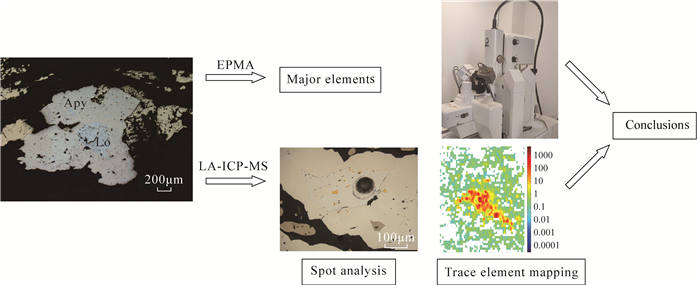
-
硫在自然界分布广泛,赋存形态多样,主要包括硫酸盐、元素硫和硫化物等。硫酸盐作为一种常见矿物,在蒸发环境中硫酸盐主要以石膏、硬石膏、钙芒硝、钠芒硝等矿物的形式存在,在热液活动中则主要以重晶石、天青石、明矾石、石膏等形式存在。
石膏分布广泛,微溶于水,大多为沉积作用的产物(海相沉积和湖相沉积),其硫同位素比值受硫源以及沉积体系的封闭/开放程度和生物作用等因素影响。通过对硫同位素的研究,并结合其他同位素的研究(如锶同位素、氧同位素等),可判断成矿物质来源(海相或陆相)、成矿过程、成矿条件(封闭蒸发条件及氧化还原特征)、成矿环境(沉积类型或沉积环境)等[1-12]。Kazuya等(2018)[13]通过研究高精度测量南极冰心的硫同位素比值的变化来探讨硫同位素组成发生变化的原因。李延河等(2014)[14]对于长江中下游玢岩铁矿中普遍存在石膏等硫酸盐矿物的硫同位素组成进行了分析统计,探讨了膏盐层氧化障在玢岩铁矿成矿中的作用,表明矿床中硫主要来自三叠纪膏盐层,矿床中黄铁矿的硫同位素组成与矿床成因类型密切相关。
国外对硫同位素分析方法的研究起源于20世纪40年代,最早是由Thode(1949)[15]首先提出并应用于地质研究中。早期的硫同位素分析方法主要为双路进样SO2法和SF6法,这种传统的分析方法就是硫以SO2和SF6的形式被送入质谱仪中,其δ34S分析误差为±0.1‰。几十年来,随着地学研究的不断深入,传统的离线制备与双路进样测试技术已不能满足硫同位素测试的需求。随着仪器设备的改进和分析测试技术手段的不断提高,硫同位素组成分析技术正在朝着微区、微量、快速、精确的方向发展,陆续产生了一系列硫同位素分析的新技术和新方法,主要有二次离子质谱法(SIMS)、激光剥蚀多接收电感耦合等离子体质谱法(LA-MC-ICP-MS)和连续流气体源同位素比质谱法(CF-IRMS)。其中,SIMS法和LA-MC-ICP-MS法的突出优点是高分辨率、可进行原位分析,可以更好地研究多期次成因硫酸盐矿物的硫同位素组成,但是存在基体效应和加合离子的干扰等问题[16]。
目前普遍采用的元素分析仪与气体同位素质谱联用技术(EA-IRMS)在线测量方法,已实现SO2制备和纯化过程的自动化。虽然无法得到微区原位的信息,但具备操作简单、快速、样品用量小、无基体效应的特点,同时也避免了硫酸盐样品繁琐的化学处理流程,可以很好地满足微量分析发展方向的需求[17-25]。已有的文献详细介绍了硫化物和硫酸钡样品的EA-IRMS在线测量方法,实现了硫化物和硫酸钡样品的直接在线测量。而对于非硫酸钡组成的硫酸钙样品,国外只有很少部分学者略有提及,也缺少具体实验研究,我国亦未见相关报道[11, 25]。
本文以石膏样品为例,提出了一种无需繁杂的化学处理流程即能够准确测定石膏硫同位素比值的直接测定方法:将石膏粉末(~200目)与适量V2O5混合后包裹于锡杯中密封,直接进行EA-IRMS检测,得到其硫同位素比值。
1. 实验部分
1.1 仪器与工作条件
硫同位素组成测试分析在自然资源部成矿作用与资源评价重点实验室完成,仪器装置为美国ThermoFisher公司的MAT-253型稳定同位素质谱仪(IRMS)、Flash 2000HT型元素分析仪(EA)和连续流接口装置(Conflo Ⅳ)。EA工作参数:反应炉温度1020℃,载气(He)流量90~110mL/min,氧化剂(O2)流量175mL/min,色谱柱温度100℃,样品的SO2峰在240s左右时开始出现,整个检测时间约600s。
1.2 实验材料和主要试剂
由于SO2气体具有黏滞性,易附着在不锈钢管道上,会造成记忆效应、本底升高,影响其他样品的测量。因此实验流程中所用色谱柱为聚四氟乙烯材料(美国ThermoFisher公司),替换了不锈钢管,以防止SO2气体附着在不锈钢管的内壁上。
实验所用高温炉反应管为石英材料,包裹样品的锡杯(9mm×5mm)购于美国ThermoFisher公司。采用的工作标准分别是:国际原子能机构(IAEA)的硫同位素参考物质IAEA-SO-5和IAEA-SO-6;美国国家标准局(NIST)的标准物质NBS-127。3个标准物质的成分都是BaSO4,其δ34SV-CDT值分别为-0.49‰、-34.09‰、21.12‰。实验选取了采自不同地区13件不同δ34S值的天然石膏样品,纯度均高于99%,δ34S值介于-20‰~+30‰之间。
实验所用的试剂V2O5为分析纯(纯度>99%),使用前装于瓷皿内,置于500℃马弗炉中灼烧1h,冷却后存于干燥器中备用;氧化剂WO3,粒度0.85~1.7mm;还原铜为长度11cm的高纯铜丝(纯度>99.9%);填充于反应管内的石英棉购于美国ThermoFisher公司。实验所用的三种主要气体:氧化剂O2、参考气SO2和载气He,皆为纯度>99.999%的钢瓶气。
1.3 实验步骤
实验选定13件纯石膏样品进行方法对比试验,对同一硫酸钙样品分别采取两种方式进行处理并进行硫同位素比值的分析。①取一部分样品(~200目,300~500μg)加入其质量2~3倍的V2O5直接在线分析。②另取一部分样品(~200目,足量)放入去离子水中进行充分溶解后,加入过量的5mol/L BaCl2溶液,将生成的BaSO4沉淀采用孔径为0.22μm的定性滤纸滤出→去离子水清洗(3~5次)→滤出→去离子水清洗(3~5次)→滤出→烘干(105℃),得到纯净的BaSO4用于在线分析。
在线分析步骤:将取得的样品与样品质量3~5倍的氧化剂V2O5混合均匀后共同包裹于锡杯中密封。由自动进样器送入填充氧化剂(WO3)和还原铜的反应管中,反应器温度1020℃。自动进样器每次投入燃烧反应器中一个样品,样品落入反应管的同时送入纯度大于99.999%的O2,此时反应管中富集纯氧,样品在锡杯的闪燃下迅速充分燃烧,生成SO3,SO3在Cu的还原下生成SO2,之后被纯度大于99.9%的He气流载入质谱分析。实验装置如图 1所示。
通常用δ值来表示样品的同位素组成,即样品相对于标准样品的34S值表示样品的硫同位素组成,即δ34S定义为:
$ {\delta ^{34}}{{\rm{S}}_{样品}} = \frac{{\left( {\frac{{^{34}{\rm{S}}}}{{^{32}{\rm{S}}}}} \right){\;_{样品}} - \left( {\frac{{^{34}{\rm{S}}}}{{^{32}{\rm{S}}}}} \right){\;_{标准}}}}{{\left( {\frac{{^{34}{\rm{S}}}}{{^{32}{\rm{S}}}}} \right){\;_{标准}}}} \times 1000$
式中:
${\left( {\frac{{^{34}{\rm{S}}}}{{^{32}{\rm{S}}}}} \right){\;_{样品}}}$ 和${\left( {\frac{{^{34}{\rm{S}}}}{{^{32}{\rm{S}}}}} \right){\;_{标准}}}$ 分别是实际样品和标准样品的34S32S的真实值。2. 结果与讨论
2.1 石膏样品硫同位素比值分析结果
13个样品分析结果如表 1所示:直接测定硫酸钙得到样品的δ34SV-CDT值的范围介于-23.91‰~32.31‰之间;硫酸钙经前处理后转化为硫酸钡得到样品的δ34SV-CDT值的范围介于-24.10‰~32.31‰之间。对比13个样品的实验结果,两种处理方式得到的结果在同一范围区间;对比每一个样品的两组硫同位素比值,二者的δ34SV-CDT 绝对差值介于0.00‰~0.24‰之间。
表 1 原始样品与经处理样品的δ34SV-CDT(‰)实测值对比Table 1. Comparison of the measured δ34SV-CDT(‰) values of original samples and treated samples样品编号 δ34SV-CDT(‰) 处理前后
的差值原始样品(CaSO4) 经处理样品(BaSO4) 样品1 -20.41 -20.65 0.24 样品2 -13.44 -13.56 0.12 样品3 0.82 0.77 0.05 样品4 1.91 2.02 0.11 样品5 -10.05 -9.95 0.10 样品6 -23.91 -24.10 0.19 样品7 15.39 15.18 0.21 样品8 30.77 30.60 0.17 样品9 24.75 24.65 0.09 样品10 32.31 32.31 0.00 样品11 19.92 20.01 0.09 样品12 8.13 8.16 0.03 样品13 -3.53 -3.62 0.09 2.2 直接在线分析结果准确性讨论
从理论上来说,经过两种处理方法的样品在线分析时直接加入适量的V2O5进行测定即可,即:
CaSO4或BaSO4中所有的硫最终都进入了SO2,所有氧的3/4首先转化成SO3,最终全氧的1/2进入了SO2。尽管CaSO4和BaSO4分解时与残余相CaO和BaO的分馏可能是不同的,但V2O5和氧气中的外部氧在瞬间燃烧的过程中替代了BaSO4本身的氧,生成的SO3和SO2气体的氧是均一的,因此,其硫同位素比值完全能代表样品的硫同位素组成,无需进行氧同位素的校正[26-27]。
$ \begin{align} & \text{BaS}{{\text{O}}_{4}}+6{{\text{V}}_{2}}{{\text{O}}_{5}}\xrightarrow{\tilde{\ }{{1000}^{\circ }}\text{C}}\text{Ba}{{\text{V}}_{12}}{{\text{O}}_{30}}+\text{S}{{\text{O}}_{3}}\uparrow +\frac{1}{2}{{\text{O}}_{2}}\uparrow \\ & \text{ S}{{\text{O}}_{3}}+2\text{Cu}\to \text{ S}{{\text{O}}_{2}}\uparrow +\text{C}{{\text{u}}_{\text{2}}}\text{O} \\ \end{align} $
实验中选择的测试样品皆为纯度较高的硫酸钙样品。其δ34S值的范围覆盖了-20‰~+30‰的区间,并呈现出良好的线性关系(图 2)。表明该方法对所有的硫酸钙样品适用,且准确、可靠。对于纯度不高的硫酸钙样品,在不含有硫化物的情况下,理论上也不会影响硫同位素比值的准确测定,符合实验允许的±0.2‰的要求。由此可以看出,硫酸钙样品的直接在线分析是完全可行的。
2.3 直接在线分析方法与常规分析方法的比较
采用SO2法分析硫同位素比值时,需要消除氧同位素对硫同位素测量的干扰。常规方法SO2法采用经半熔法得到的BaSO4来消除氧同位素组成不均对δ34S测定值带来的影响。即将硫酸盐矿物经Na2CO3-ZnO半熔、BaCl2沉淀、过滤和灼烧获得BaSO4,BaSO4与SiO2一起在真空中用火焰加热, 分解为SO3,再经铜还原,生成SO2[28],在转化的过程中氧同位素组成达到均一化,不会对δ34S的测量产生干扰。而本研究建立的直接在线分析方法,无需任何化学前处理,直接加入适量的V2O5进行测定即可,V2O5和氧气中的外部氧在瞬间燃烧的过程中替代了硫酸钙或硫酸钡本身的氧,生成的SO2气体的氧是均一的,其硫同位素比值能代表样品的硫同位素组成,无需进行氧同位素的校正。因而,与常规方法相较,采用EA-IRMS在线分析硫酸钙粉末中硫同位素比值的方法具备分析快速、样品用量少和操作简单的特点。
3. 结论
本研究建立的直接在线分析硫酸钙的硫同位素比值的分析方法,实现了石膏样品的硫同位素EA-IRMS直接快速在线分析,省去了繁杂的BaSO4转换过程,不需要任何化学上或技术上的处理,提高了分析效率。
石膏作为一种分布广泛的硫酸盐矿物,通过研究其硫同位素组成特点,不仅可为寻找固体盐/蒸发岩类矿床提供基础,还可辅助性地为研究其他含硫矿床的成因提供依据。因此,该方法的建立将为石膏硫同位素在地质和环境领域的研究提供很好的技术支持,尤其有利于研究微小尺度内(微小范围)石膏样品的硫同位素组成。
致谢: 感谢中国地质科学院矿产资源研究所陈振宇研究员和陈小丹老师在电子探针分析上提供的帮助,感谢南京聚谱检测科技有限公司实验员朱鹏在LA-ICP-MS测试分析上提供的帮助,同时感谢审稿专家对论文提出宝贵的修改意见。 -
图 2 浩尧尔忽洞金矿脆-韧性剪切变形-热液成矿期矿化特征
递进剪切变形阶段:a—剪切揉皱石英脉;b—石香肠化石英脉;c—定向拉长硫化物细脉;d—石英脉剪切并充填硫化物;e—压溶石英透镜体;f—定向拉长毒砂硫化物细脉。后剪切变形阶段:g—强剪切带中毒砂呈浸染状产出;h—细脉和团块状毒砂石英脉;i—含自然金石英脉。
Figure 2. Mineralization characteristics of Haoyaoerhudong gold deposit during brittle-ductile shear deformation-hydrothermal metallogenic stage
图 3 浩尧尔忽洞金矿毒砂光学显微镜反射光和电子背散射图像特征
a—自形毒砂与黄铁矿、磁黄铁矿定向排列呈细脉;b、d—多孔状毒砂Apy-Ⅰ1表面干净的毒砂Apy-Ⅰ2;c—Apy-Ⅰ2颗粒内发育Lo-Ⅰ,被磁黄铁矿交代;e—多孔状毒砂Apy-Ⅱ1和表面干净的毒砂Apy-Ⅱ2;f-Apy-Ⅱ2颗粒内发育Lo-Ⅱ和磁黄铁矿,自然金分布于斜方砷铁矿内和其与毒砂接触的界面处;g—黄铜矿细脉切穿Apy-Ⅱ2;h—黄铁矿细脉切穿Apy-Ⅱ2和Lo-Ⅱ;i—Apy-Ⅱ2内部发育自然金。
a~c、e~g为反光镜照片,d、h、i为背散射图像;Py—黄铁矿;Apy—毒砂;Po—磁黄铁矿;Lo—斜方砷铁矿;Au—自然金。Figure 3. Optical (reflected light) and electron backscattering images of arsenopyrite in Haoyaoerhudong gold deposit
表 1 毒砂和斜方砷铁矿的EPMA测试条件
Table 1 EPMA analytical conditions of arsenopyrite and loellingite
元素 分析晶体 特征X射线 计数时间(s) 标样矿物 检出限(μg/g) 峰位 背景 As TAP Lα 10 5 砷化镓(GaAs) 53~105 Sb PETH Lα 10 5 硫化锑(Sb2S3) 270~294 Pb PETJ Mα 10 5 方铅矿(PbS) 110~136 S PETJ Kα 10 5 黄铜矿(CuFeS2) 18~39 Ag PETH Lα 10 5 硫砷银矿(Ag3AsS3) 190~246 Fe LIF Kα 10 5 黄铁矿(FeS2) 138~186 Cu LIF Kα 10 5 黄铜矿(CuFeS2) 339~473 Au PETH Mα 10 5 金(Au) 146~192 Co LIF Kα 10 5 钴(Co) 294~374 Ni LIFH Kα 10 5 硫化镍(NiS) 111~155 Zn LIF Kα 10 5 闪锌矿(ZnS) 203~437 表 2 毒砂、斜方砷铁矿电子探针分析结果
Table 2 Electron probe microanalysis of arsenopyrite and loellingite
测点编号 矿物 元素含量(%) As Sb Pb S Ag Fe Cu Au Co Ni Zn 总计 B228(2)-1-3 毒砂
(Apy-Ⅰ1)45.78 - 0 18.51 0 34.87 - - 0.465 0.5 0 100.16 B228(2)-2-1 45.81 0.029 0.017 18.96 0 34.94 - 0 0.491 0.506 0 100.76 B228(2)-2-3 45.85 0.08 0.07 19.09 0.037 34.25 0 0 0.356 0.438 0 100.16 B241(1)-1-1 45.27 - 0.1 19.86 - 33.92 0 0.049 0.243 0.145 - 99.61 B241(1)-1-3 45.55 0.039 0.214 18.61 0 34.48 0 0 0.357 0.284 0 99.53 B241(1)-2-4 45.32 - 0 19.41 0 34.46 0 0 0.373 0.23 0 99.79 B241(2)-1-1 45.99 0.043 0.074 19.01 - 34.06 0 0 0.26 0.424 0 99.87 B241(1)-1-2 毒砂
(Apy-Ⅰ2)45.53 0.044 - 18.91 0 34.48 0 0.038 0.388 0.166 0 99.56 B241(1)-2-1 45.21 0 0 19.32 0 34.52 - 0.088 0.271 0.154 0 99.56 B228(2)-1-1 45.64 - 0 18.99 0.035 34.36 0 0 0.361 0.375 0 99.79 B228(2)-1-2 斜方砷铁矿
(Lo-Ⅰ)66.05 0.048 0.132 2.41 0 28.27 - 0 0.541 2.584 - 100.04 B228(2)-2-2 67.63 0.047 0 1.00 - 27.14 0 0 0.607 3.152 0.034 99.60 B241(1)-2-2 64.06 - 0.033 2.34 0 29.53 0 0 0.483 1.233 0 97.70 B241(2)-1-2 65.98 0 0 2.65 0 28.98 0 0 0.332 2.146 0 100.09 B241(2)-1-3 66.17 0 0.066 2.27 - 28.85 0 0 0.342 2.237 0 99.95 B183-5 毒砂
(Apy-Ⅱ1)45.37 0 0 19.00 - 33.86 0 0.133 0.431 0.506 0 99.31 B352-3-2 45.18 - 0 18.11 0 33.81 0 - 3.346 0.213 0 100.68 B219-1-2 45.29 - 0 18.40 0.033 34.37 0 0 2.03 0.562 0 100.69 B263(2)-1-3 45.58 0 0.018 18.60 0 33.84 0.031 0 1.242 0.878 0 100.19 B263(2)-2-2 45.31 0 0.035 19.30 - 33.97 0 0.088 1.282 0.675 0 100.66 B263(2)-2-3 45.61 0 0 18.96 0 33.87 0 0.022 1.255 0.727 0 100.44 B183-1 毒砂
(Apy-Ⅱ2)44.97 0 0.065 19.58 0 34.20 0 0 0.379 0.444 0.089 99.72 B352-1-1 44.46 0 0 18.70 - 34.69 - 0 2.212 0.201 0 100.29 B219-2-1 44.36 - 0.013 18.64 - 34.68 0 - 1.943 0.372 0 100.04 B263(1)-1-2 44.03 - 0 18.65 - 35.08 0 0.033 1.463 0.424 0 99.70 B263(2)-1-1 45.56 0 - 17.26 0 34.74 0 0 1.128 0.856 0 99.54 B263(2)-2-1 45.43 0 0 19.11 0.026 34.01 0 - 1.32 0.617 0 100.53 B263(1)-2-2 45.35 - 0.119 18.82 0 34.05 0 0.04 1.418 0.538 - 100.36 B263(1)-3-1 44.30 0 0 18.99 0.026 34.95 0 0 1.28 0.431 0 99.98 B183-2 斜方砷铁矿
(Lo-Ⅱ)66.26 0 0.033 1.52 0.019 26.27 0 0 0.639 3.846 0 98.59 B183-4 66.55 0 0 2.02 - 26.82 - 0.085 0.612 3.615 - 99.75 B352-1-2 67.80 0 0 0.97 0 24.44 0 0 4.951 1.807 0 99.96 B352-3-1 66.20 0 0.122 2.34 0 25.26 0 0.078 4.977 1.592 0 100.57 B219-1-1 67.87 0 0.081 1.08 0 24.79 0 0 2.763 3.471 0 100.04 B219-2-3 67.48 - 0.066 0.74 0.019 24.46 - 0 2.952 3.434 0 99.16 B263(1)-1-1 67.07 0.09 0.071 1.67 0 25.55 0 0.049 2.001 3.441 0 99.94 B263(1)-2-1 66.96 0.028 0.071 1.81 - 25.77 - 0.03 1.997 3.53 0 100.21 B263(1)-3-2 66.29 0 0.061 2.24 - 26.27 0 0.036 1.72 3.152 0 99.77 B263(2)-1-2 66.29 0 0.043 1.69 0 22.80 0 0 1.624 6.371 0 98.83 B263(2)-2-4 66.41 0 0.104 1.82 0.05 23.55 0 0 1.76 5.822 0 99.51 B263(2)-2-5 66.52 0 0 1.63 0.047 23.44 0 0 1.731 5.965 0 99.34 注:“-”表示元素含量低于检测限。 表 3 毒砂、斜方砷铁矿LA-ICP-MS分析结果
Table 3 LA-ICP-MS analysis of arsenopyrite and loellingite
测点编号 矿物 元素含量(μg/g) Au Co Ni Sb Te Bi Pb Se Ag Cu Zn Ba Al Ti Mn B190(3)-3 毒砂
(Apy-Ⅰ1)0.08 5267 1510 196.32 14.64 91.05 12.82 11.88 3.00 45.41 3.97 0.27 591.27 3.93 660.59 B171(2)-3 0.70 13596 1147 274.62 15.32 47.47 2.53 6.07 0.23 0.64 1.48 2.64 441.49 20.06 2.75 B164(2)-5 0.81 10505 5034 135.60 22.13 78.42 7.06 9.54 0.73 0 1.80 3.63 876.66 17.84 9.28 B241(1)-1 12.37 1205 860 195.60 64.66 32.62 1.17 16.66 0.17 0.23 0.69 1.65 259.60 17.47 1.66 B241(1)-2 1470.74 1443 1756 206.00 656.40 3117.29 7.23 13.06 170.77 0.87 2.71 9.67 1724.68 159.63 15.98 平均 3.49 6403 2061 201.63 154.63 673.37 6.16 11.44 1.03 11.79 2.13 3.57 778.74 43.79 138.05 B241(1)-3 毒砂
(Apy-Ⅰ2)0.34 1102 766 174.65 46.74 0.35 - 12.58 0.39 0.44 7.11 0.03 0 - 0.51 B171(2)-2 0.06 13157 1258 276.13 11.36 0.26 0.01 4.01 0 0 - 0.02 - - 0 B190(3)-1 0.11 9867 2265 191.93 14.86 3.19 0.42 9.70 0 93.52 - 0.45 47.13 6.98 1.76 B164(2)-1 0.28 9999 1261 149.34 12.46 9.89 0.30 9.23 0.31 - 2.75 3.69 251.98 21.95 7.06 平均 0.20 8531 1388 198.01 21.36 3.42 0.24 8.88 0.35 0.44 4.93 1.05 149.56 14.46 3.11 B241(1)-4 斜方砷铁矿
(Lo-Ⅰ)125.15 1334 4459 147.69 319.25 1554.98 2.79 12.68 15.53 1.02 0.52 0.03 21.99 0.98 1.89 B171(2)-4 58.60 9186 6214 163.44 78.14 1119.76 1.28 3.64 5.81 0 4.11 3.84 632.47 40.12 10.77 B256-1-1 29.24 12952 12024 140.24 42.62 37.02 - 6.97 0.56 0.02 13.93 - 10.36 0 1.01 B256-1-3 14.04 10047 11280 100.19 56.19 7.72 - 9.51 0 0 0 0.50 143.01 6.59 - B228-02-1 13.18 1787 11037 152.43 39.56 43.50 0.53 13.78 0 0 - 1.31 217.67 9.66 - B228-02-3 22.28 1387 10094 118.66 35.84 1.06 - 18.71 - 0 - 0 1.59 0 0 B241-2-1 27.01 920 8199 132.52 32.12 0.37 0 - 0 0 0 0 - - - 平均 41.36 5373 9044 136.45 86.24 394.92 1.53 10.88 7.30 0.52 6.19 1.42 171.18 14.34 4.55 B352-2 毒砂
(Apy-Ⅱ1)0.57 17114 1092 153.23 40.96 24.42 3.85 4.56 0.16 0.93 - - 3.51 0.64 - B352-7 0.32 11992 721 119.16 36.29 15.07 1.28 4.74 0.31 0.38 - 1.69 60.37 2.68 1.67 B263(2)-2 0.60 5037 5010 98.64 35.92 13.75 1.12 12.64 0.06 0.36 1.38 3.55 281.94 22.32 9.60 B263(1)-5 0.49 8908 3354 153.76 60.67 11.58 1.62 7.91 0.04 - - 0.11 20.45 1.67 9.32 平均 0.50 10763 2544 131.20 43.46 16.20 1.97 7.46 0.15 0.56 1.38 1.78 91.57 6.83 6.86 B217(1)-2 毒砂
(Apy-Ⅱ2)0.24 12235 2189 326.33 23.79 1.05 0.08 6.38 0 0.58 0 0.12 12.46 3.15 0.98 B217(1)-4 0.48 9847 2474 333.20 28.18 4.86 3.16 9.31 - 0 0.68 - 3.98 - 0 B352-6 0.49 14627 1052 134.01 38.19 0.65 0.43 5.20 0 496.77 8.59 0.03 2.75 0 0.40 B352-4 0.23 11925 774 150.47 41.84 1.61 0.12 3.09 0.10 0 0.82 0.70 144.42 21.98 7.88 TB352-4 0.09 13060 1318 129.57 18.92 1.89 0.25 5.42 0.04 0 1.02 0.12 33.97 3.76 2.05 B263(1)-4 0.31 7470 3269 151.74 51.00 0.58 0.03 5.81 0.01 0.51 - 0.03 0.75 - - B263(2)-1 0.22 4231 3724 80.48 26.58 0.77 0.03 11.00 0 0.26 0.48 0.01 0.32 - 0.37 B263(1)-1 0.27 7235 2892 152.93 50.82 1.96 0.17 6.24 0 0 0 0.02 0 0.96 0 B263(3)-1 0.06 2438 630 77.99 26.29 0.34 - 9.52 0 - 0.40 0 0 - 0.33 平均 0.26 9230 2036 170.75 33.96 1.52 0.54 6.89 0.05 0.45 2.00 0.15 28.38 7.46 2.00 B352-5 斜方砷铁矿
(Lo-Ⅱ)1496.33 9874 4873 484.41 1733.03 15908.75 41.76 5.13 124.75 2.11 1.62 5.91 927.91 19.31 3.74 B217(1)-3 1409.11 12145 15303 368.04 475.07 9073.09 27.33 5.41 40.30 1.91 709.43 0.73 44.05 18.14 2.71 B217(1)-5 108.76 4033 5251 204.96 454.37 5936.41 29.02 6.65 8.77 0 - 0.20 79.98 2.41 2.69 B183-1 1656.97 1692 11690 619.91 1721.39 39714.13 34.69 - 23.97 - 125.53 212.27 16689.82 1215.42 198.35 B183-2 75.96 1964 12500 100.47 143.48 1163.09 5.57 22.49 7.11 0 30.90 33.54 4176.58 538.89 110.59 B183-4 45.45 2414 14312 106.73 66.05 735.19 - 24.11 2.62 0 0 0.18 31.67 35.64 0 B263(3)-2 12.30 8167 5492 56.77 51.68 53.85 0.48 9.43 3.46 23.39 1.62 3.61 509.77 19.40 11.39 B263(1)-2 11.89 6697 12912 123.14 71.23 1.00 0.26 3.95 - 10.83 5.91 - - 1.64 0 平均 602.10 5873 10292 258.05 589.54 9073.19 19.87 11.02 30.14 9.56 145.84 36.63 3208.54 231.36 41.18 注:“-”表示元素含量低于检测限。 -
Morey A A, Tomkins A G, Bierlein F P, et al. Bimodal distribution of gold in pyrite and arsenopyrite: Examples from the Archean Boorara and Bardoc shear systems, Yilgarn Craton, western Australia[J]. Economic Geology, 2008, 103: 599-614. doi: 10.2113/gsecongeo.103.3.599
Zoheir B, Goldfarb R, Holzheid A, et al. Geochemical and geochronological characteristics of the Um Rus granite intrusion and associated gold deposit, Eastern Desert, Egypt[J]. Geoscience Frontiers, 2020, 11(1): 325-345. doi: 10.1016/j.gsf.2019.04.012
Tomkins A G, Mavrogenes J A. Redistribution of gold within arsenopyrite and Lollingite during pro- and retrograde metamorphism: Application to timing of mineralization[J]. Economic Geology, 2001, 96: 525-534. doi: 10.2113/gsecongeo.96.3.525
Deol S, Deb M, Large R R, et al. LA-ICPMS and EPMA studies of pyrite, arsenopyrite and loellingite from the Bhukia—Jagpura gold prospect, southern Rajasthan, India: Implications for ore genesis and gold remobilization[J]. Chemical Geology, 2012, 326-327: 72-87. doi: 10.1016/j.chemgeo.2012.07.017
卢焕章, 朱笑青, 单强, 等. 金矿床中金与黄铁矿和毒砂的关系[J]. 矿床地质, 2013, 32(4): 824-843. https://www.cnki.com.cn/Article/CJFDTOTAL-KCDZ201304016.htm Lu H Z, Zhu X Q, Shan Q, et al. Hydrothermal evolution of gold-bearing pyrite and arsenopyrite from different types of gold deposits[J]. Mineral Deposit, 2013, 32(4): 824-843. https://www.cnki.com.cn/Article/CJFDTOTAL-KCDZ201304016.htm
陈懋弘, 毛景文, 陈振宇, 等. 滇黔桂"金三角"卡林型金矿含砷黄铁矿和毒砂的矿物学研究[J]. 矿床地质, 2009, 28(5): 539-557. doi: 10.3969/j.issn.0258-7106.2009.05.002 Chen M H, Mao J W, Chen Z Y, et al. Mineralogy of arsenian pyrites and arsenopyrites of Carlin-type gold deposits in Yunnan—Guizhou—Guangxi "golden triangle" area, southwestern China[J]. Mineral Deposit, 2009, 28(5): 539-557. doi: 10.3969/j.issn.0258-7106.2009.05.002
张乐骏, 周涛发. 矿物原位LA-ICPMS微量元素分析及其在矿床成因和预测研究中的应用进展[J]. 岩石学报, 2017, 33(11): 3437-3452. https://www.cnki.com.cn/Article/CJFDTOTAL-YSXB201711007.htm Zhang L J, Zhou T F. Minerals in-situ LA-ICPMS trace elements study and the applications in ore deposit genesis and exploration[J]. Acta Petrologica Sinica, 2017, 33(11): 3437-3452. https://www.cnki.com.cn/Article/CJFDTOTAL-YSXB201711007.htm
周伶俐, 曾庆栋, 孙国涛, 等. LA-ICPMS原位微区面扫描分析技术及其矿床学应用实例[J]. 岩石学报, 2019, 35(7): 1964-1978. https://www.cnki.com.cn/Article/CJFDTOTAL-YSXB201907002.htm Zhou L L, Zeng Q D, Sun G T, et al. Laser ablation inductively coupled plasma mass spectrometry (LA-ICPMS) elemental mapping and its applications in ore geology[J]. Acta Petrologica Sinica, 2019, 35(7): 1964-1978. https://www.cnki.com.cn/Article/CJFDTOTAL-YSXB201907002.htm
李超, 王登红, 屈文俊, 等. 关键金属元素分析测试技术方法应用进展[J]. 岩矿测试, 2020, 39(5): 658-669. doi: 10.15898/j.cnki.11-2131/td.201907310115 Li C, Wang D H, Qu W J, et al. A review and perspective on analytical methods of critical metal elements[J]. Rock and Mineral Analysis, 2020, 39(5): 658-669. doi: 10.15898/j.cnki.11-2131/td.201907310115
范宏瑞, 李兴辉, 左亚彬, 等. LA-(MC)-ICPMS和(Nano)SIMS硫化物微量元素和硫同位素原位分析与矿床形成的精细过程[J]. 岩石学报, 2018, 34(12): 3479-3496. https://www.cnki.com.cn/Article/CJFDTOTAL-YSXB201812002.htm Fan H R, Li X H, Zuo Y B, et al. In-situ LA-(MC)-ICPMS and (Nano) SIMS trace elements and sulfur isotope analyses on sulfides and application to confine metallogenic process of ore deposit[J]. Acta Petrologica Sinica, 2018, 34(12): 3479-3496. https://www.cnki.com.cn/Article/CJFDTOTAL-YSXB201812002.htm
Zhang H D, Liu J C, Mostafa F. Multistage mineralization in the Haoyaoerhudong gold deposit, Central Asian Orogenic Belt: Constraints from the sedimentary-diagenetic and hydrothermal sulfides and gold[J]. Geoscience Frontiers, 2021, 12(2): 587-604. doi: 10.1016/j.gsf.2020.08.003
李园. 内蒙古浩尧尔忽洞金矿床黄铁矿成因矿物学研究及成矿预测[D]. 北京: 中国地质大学(北京), 2015. Li Y. The pyrite genetic mineralogy and metallogenic prediction of the Haoyaoerhudong gold deposit, Inner Mongolia Autonomous Region, China[D]. Beijing: China University of Geosciences (Beijing), 2015.
王建平, 刘家军, 江向东, 等. 内蒙古浩尧尔忽洞金矿床黑云母氩氩年龄及其地质意义[J]. 矿物学报, 2011, 31(S1): 643-644. https://www.cnki.com.cn/Article/CJFDTOTAL-KWXB2011S1335.htm Wang J P, Liu J J, Jiang X D, et al. The argon age and its geological significance of black mica of the Haoyaoerhudong gold deposit in Inner Mongolia[J]. Acta Mineralogica Sinica, 2011, 31(S1): 643-644. https://www.cnki.com.cn/Article/CJFDTOTAL-KWXB2011S1335.htm
Wang J P, Liu J J, Peng R M, et al. Gold mineralization in Proterozoic black shales: Example from the Haoyaoerhudong gold deposit, northern margin of the North China Craton[J]. Ore Geology Reviews, 2014, 63: 150-159. doi: 10.1016/j.oregeorev.2014.05.001
王得权, 王建国, 王义忠, 等. 内蒙浩尧尔忽洞金矿流体包裹体和矿床成因研究[J]. 地质力学学报, 2015, 21(4): 517-526. doi: 10.3969/j.issn.1006-6616.2015.04.007 Wang D Q, Wang J G, Wang Y Z, et al. Study on fluid inclusions and genetic type of Haoyaoerhudong gold deposit, Inner Mongolia[J]. Journal of Geomechanics, 2015, 21(4): 517-526. doi: 10.3969/j.issn.1006-6616.2015.04.007
Zhang H D, Liu J C, Xu Q, et al. Geochronology, isotopic chemistry, and gold mineralization of the black slate-hosted Haoyaoerhudong gold deposit, northern North China Craton[J]. Ore Geology Reviews, 2020, 117: 103315. doi: 10.1016/j.oregeorev.2020.103315
Wang J P, Wang X, Liu J J, et al. Geology, geochemistry, and geochronology of gabbro from the Haoyaoerhudong gold deposit, Northern Margin of the North China Craton[J]. Minerals, 2019, 9(1): 63. doi: 10.3390/min9010063
肖伟, 聂凤军, 刘翼飞, 等. 内蒙古长山壕金矿区花岗岩同位素年代学研究及地质意义[J]. 岩石学报, 2012, 28(2): 535-543. https://www.cnki.com.cn/Article/CJFDTOTAL-YSXB201202016.htm Xiao W, Nie F J, Liu Y F, et al. Isotope geochronology study of the granitoid intrusions in the Changshanhao gold deposit and its geological implications[J]. Acta Petrologica Sinica, 2012, 28(2): 535-543. https://www.cnki.com.cn/Article/CJFDTOTAL-YSXB201202016.htm
Liu Y F, Nie F J, Jiang S H, et al. Geology, geochrono-logy and sulphur isotope geochemistry of the black schist-hosted Haoyaoerhudong gold deposit of Inner Mongolia, China: Implications for ore genesis[J]. Ore Geology Reviews, 2016, 73: 253-269. doi: 10.1016/j.oregeorev.2014.12.020
Liu Y S, Hu Z C, Gao S, et al. In situ analysis of major and trace elements of anhydrous minerals by LA-ICP-MS without applying an internal standard[J]. Chemical Geology, 2008, 257(1-2): 34-43. doi: 10.1016/j.chemgeo.2008.08.004
宁思远, 汪方跃, 薛纬栋, 等. 长江中下游铜陵地区宝山岩体地球化学研究[J]. 地球化学, 2017, 46(5): 397-412. doi: 10.3969/j.issn.0379-1726.2017.05.001 Ning S Y, Wang F Y, Xue W D, et al. Geochemistry of the Baoshan pluton in the Tongling region of the Lower Yangtze River Belt[J]. Geochimica, 2017, 46(5): 397-412. doi: 10.3969/j.issn.0379-1726.2017.05.001
汪方跃, 葛粲, 宁思远, 等. 一个新的矿物面扫描分析方法开发和地质学应用[J]. 岩石学报, 2017, 33(11): 3422-3436. https://www.cnki.com.cn/Article/CJFDTOTAL-YSXB201711006.htm Wang F Y, Ge C, Ning S Y, et al. A new approach to LA-ICP-MS mapping and application in geology[J]. Acta Petrologica Sinica, 2017, 33(11): 3422-3436. https://www.cnki.com.cn/Article/CJFDTOTAL-YSXB201711006.htm
Xiao X, Zhou T F, White N C, et al. The formation and trace elements of garnet in the skarn zone from the Xinqiao Cu-S-Fe-Au deposit, Tongling ore district, Anhui Province, eastern China[J]. Lithos, 2018, 302-303: 467-479. doi: 10.1016/j.lithos.2018.01.023
Sharp Z D, Essene E J, Kelly W C. A re-examination of the arsenopyrite geothermometer: Pressure considerations and applications to natural assemblages[J]. Canadian Mineralogist, 1985, 23: 517-534.
Thomas H V, Large R R, Bull S W, et al. Pyrite and pyrrhotite textures and composition in sedimentary rocks, laminated quartz veins, and gold reefs at the Bendigo mine, Australia: Insights for ore genesis[J]. Economic Geology, 2011, 106(1): 1-31. doi: 10.2113/econgeo.106.1.1
Large R R, Danyushevsky L V, Hollit C, et al. Gold and trace element zonation in pyrite using a laser imaging technique: Implications for the timing of gold in orogenic and Carlin-style sediment-hosted deposits[J]. Economic Geology, 2009, 104: 635-668. doi: 10.2113/gsecongeo.104.5.635
李立兴, 李厚民, 丁建华, 等. 东天山维权银铜矿床中钴矿化发现及成因意义[J]. 矿床地质, 2018, 37(4): 778-796. https://www.cnki.com.cn/Article/CJFDTOTAL-KCDZ201804005.htm Li L X, Li H M, Ding J H, et al. The discovery of cobaltite mineralization in Weiquan Ag-Cu deposit, eastern Tianshan Mountains, and its significance[J]. Mineral Deposit, 2018, 37(4): 778-796. https://www.cnki.com.cn/Article/CJFDTOTAL-KCDZ201804005.htm
张金阳, 马昌前, 李建威. 东昆仑水闸东沟—黄龙沟金矿床硫化物矿物学特征对可见金形成条件的制约[J]. 矿床地质, 2012, 31(6): 1184-1194. doi: 10.3969/j.issn.0258-7106.2012.06.005 Zhang J Y, Ma C Q, Li J W. Visible gold-forming environment evidenced by sulfide mineralogical characteristics of Shuizhadonggou—Huanglonggou gold deposit in eastern Kunlun Orogen[J]. Mineral Deposit, 2012, 31(6): 1184-1194. doi: 10.3969/j.issn.0258-7106.2012.06.005
Sahoo P R, Venkatesh A S. Constraints of mineralogical characterization of gold ore: Implication for genesis, controls and evolution of gold from Kundarkocha gold deposit, eastern India[J]. Journal of Asian Earth Sciences, 2015, 97(Part A): 136-149.
汪超, 王瑞廷, 刘云华, 等. 陕西商南三官庙金矿床地质特征、金的赋存状态及矿床成因探讨[J]. 矿床地质, 2021, 40(3): 491-508. https://www.cnki.com.cn/Article/CJFDTOTAL-KCDZ202103006.htm Wang C, Wang R T, Liu Y H, et al. Geological characteristics, modes of occurrence of gold and genesis of San'guanmiao gold deposit, Shangnan, Shaanxi Province[J]. Mineral Deposit, 2021, 40(3): 491-508. https://www.cnki.com.cn/Article/CJFDTOTAL-KCDZ202103006.htm
Large R R, Maslennikov V, Robert F, et al. Multistage sedimentary and metamorphic origin of pyrite and gold in the Giant Sukhoi Log deposit, Lena Gold Province, Russia[J]. Economic Geology, 2007, 102: 1233-1267. doi: 10.2113/gsecongeo.102.7.1233
Cook N J, Ciobanu L R, Meria D, et al. Arsenopyrite-pyrite association in an orogenic gold ore: Tracing mineralization history from textures and trace elements[J]. Economic Geology, 2013, 188(6): 1273-1283.
-
期刊类型引用(10)
1. 乔柱,王恒,苏明跃,赵秀荣,张萍萍,王永红. 质量吸收系数修正-X射线衍射外标法定量分析氧化铁皮中4种物相. 冶金分析. 2024(07): 55-61 .  百度学术
百度学术
2. 李磊,张青,范慧,阳珊,遇祯. 土壤中高岭石的X射线衍射全谱拟合定量分析方法研究. 安徽地质. 2023(03): 282-287 .  百度学术
百度学术
3. 张启燕,史维鑫,刘晓,回广骥,原春雨. 高光谱扫描在碳酸盐岩矿物组成分析中的应用. 岩矿测试. 2022(05): 815-825 .  本站查看
本站查看
4. 赵彦钊,呼浩,杨崔月,胡智敏,李晋东,殷海荣. 锂电池正极材料烧成用匣钵物相的半定量分析. 陕西科技大学学报. 2021(05): 126-130+145 .  百度学术
百度学术
5. 徐速,戴苏兰,石小平,陈大鹏,曲蔚,罗琴凤,夏玉梅. 碧石的宝石学分类及定义界定初探. 矿物岩石. 2021(04): 1-13 .  百度学术
百度学术
6. 温利刚,贾木欣,王清,付强,赵建军. 自动矿物学:Ⅰ.技术进展与应用. 中国矿业. 2020(S1): 341-349 .  百度学术
百度学术
7. 徐颖,邓利蓉,芦玉峰,左联,杜广报. 热处理对柯尔碱膨润土微观结构和物化性能的影响. 岩矿测试. 2019(03): 280-287 .  本站查看
本站查看
8. 郑建国,于南树,刘永秀,胡善明,胡兆平. 利用磷尾矿合成新型缓释肥料聚磷酸钙镁的试验研究. 化工矿物与加工. 2019(07): 64-67+71 .  百度学术
百度学术
9. 冉敬,郭创锋,杜谷,王凤玉. X射线衍射全谱拟合法分析蓝晶石的矿物含量. 岩矿测试. 2019(06): 660-667 .  本站查看
本站查看
10. 陈乐,赵昕,游翠纯,朱肖峰. 金红石晶种的X射线衍射分析及其转化率测定. 分析测试技术与仪器. 2018(04): 236-240 .  百度学术
百度学术
其他类型引用(4)




 下载:
下载:

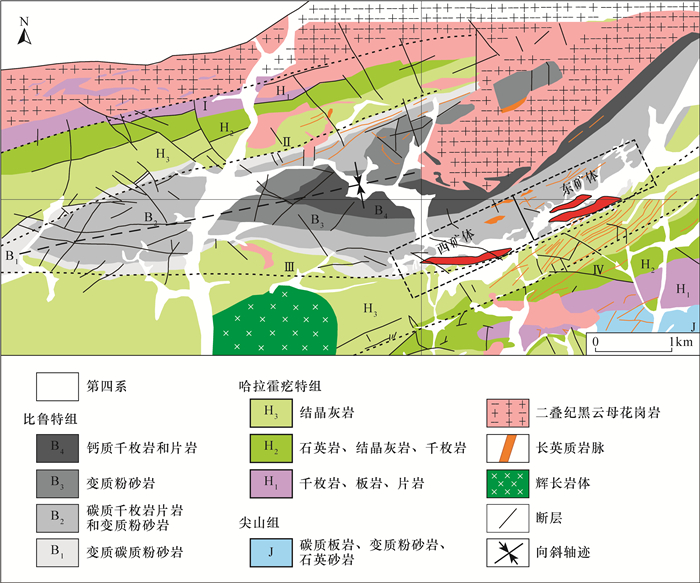
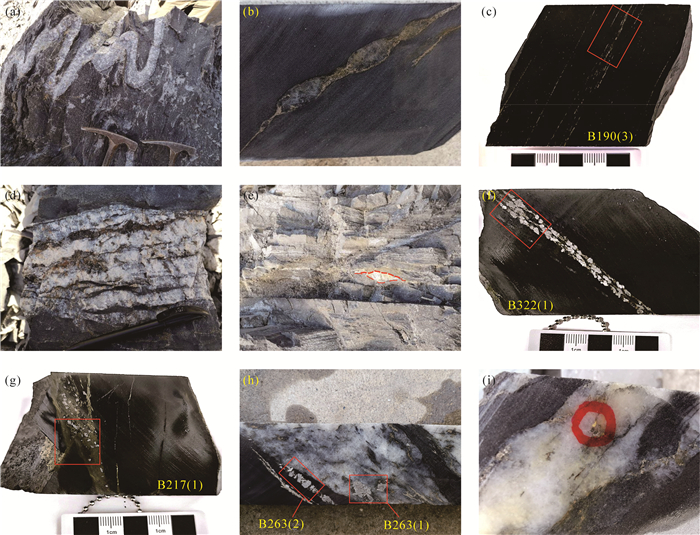
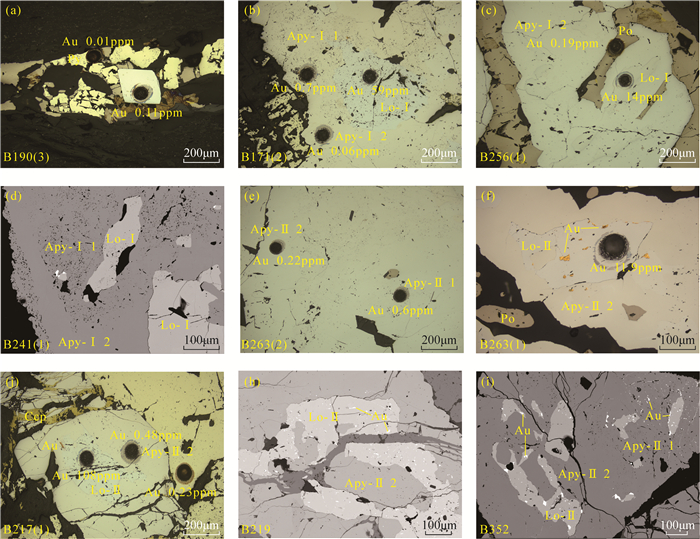
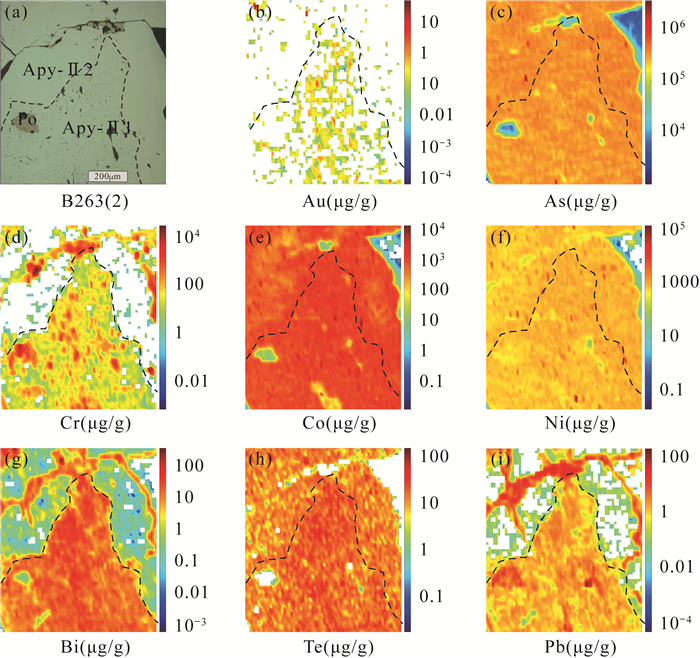


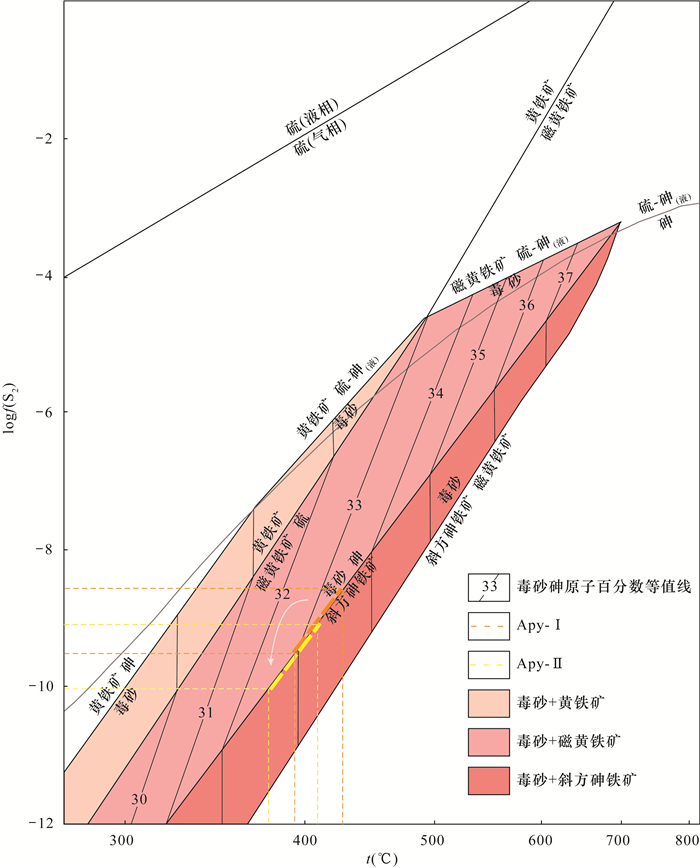
 京公网安备 11010202008159号
京公网安备 11010202008159号